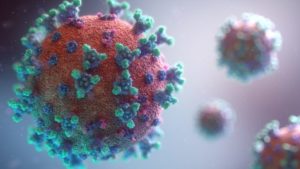 The reduced levels of angiotensin converting enzyme (ACE) 2 associated with cardiovascular disease and increasing age lead to a higher susceptibility to greater disease severity in COVID-19. A viewpoint published online in JAMA Cardiology hypothesises that severe acute respiratory syndrome coronavirus 2 (SARS-CoV-2) binding to ACE2 acutely exaggerates the proinflammatory background created by lower levels of ACE 2 in this subpopulation, predisposing them to greater COVID-19 disease severity and mortality.
The reduced levels of angiotensin converting enzyme (ACE) 2 associated with cardiovascular disease and increasing age lead to a higher susceptibility to greater disease severity in COVID-19. A viewpoint published online in JAMA Cardiology hypothesises that severe acute respiratory syndrome coronavirus 2 (SARS-CoV-2) binding to ACE2 acutely exaggerates the proinflammatory background created by lower levels of ACE 2 in this subpopulation, predisposing them to greater COVID-19 disease severity and mortality.
Authors Majd AlGhatrif (National Institute on Aging, National Institutes of Health, and Department of Medicine, Johns Hopkins School of Medicine, Baltimore, USA) and colleagues write: “This hypothesis is in line with the evidence of a protective role of angiotensin II antagonism against sepsis-associated acute lung injury, and supports continuing therapy with ACEIs/ARBs [angiotensin-converting enzyme inhibitors/angiotensin receptor blockers] and, more so, urgently calls for expanding ongoing trials treating patients with severe COVID-19 with RAS [renin angiotensin system] interventions to examine the role of these interventions in preventing lethal lung complications of COVID-19 as cases surge around the world.”
AlGhatrif et al note that previous proposals that an increase in ACE2 expression (upregulated in patients with cardiovascular disease and diabetes treated with ACE inhibitors and ARBs) underpins the greater COVID-19 severity in this population, and has led to controversy around whether these treatments should be discontinued.
They say, despite the very limited information available, the urgency of the pandemic means that “inductive reasoning” is required to “unravel this complex dilemma” and point out: “What has been missing in discussions … is the age-associated decline in ACE2 expression, as observed in the lungs of rats, which is in line with a constellation of major proinflammatory changes perpetrated by an age-associated increase in RAS signalling throughout the body. Exaggerated forms of this proinflammatory profile are also salient pathophysiologic features of hypertension and diabetes, which are highly prevalent at older ages.”
This, they say, leads to a paradox: “Given ACE2 itself is the gateway of SARS-CoV-2 entry into cells, how can the reduction in ACE2 levels in older persons and those with CVD predispose for greater COVID-19 severity?”
To address this, they suggest it is plausible that greater expression of ACE2 leads to higher predisposition to incur COVID-19, citing preliminary epidemiologic data from South Korea, “where the most population-wide testing has taken place”(at the time of writing the manuscript), which show that most cases are among younger adults, who would be expected to have higher levels of ACE2.
But, they say that severity of disease is affected by the reduction in ACE2 levels that occurs with ageing and cardiovascular disease, which causes an upregulation of angiotensin II proinflammatory pathway: “The increase in ACE2 levels with ACEI/ARB treatment is more likely to be corrective to these changes.” This is exploited with SARS-CoV-2 binding to ACE2, further reducing ACE2 cell surface expression, upregulating angiotensin II signalling in the lungs, and yielding acute lung injury.
“Hence,” they conclude, “compared with young individuals, older persons with CVD who already have reduced ACE2 levels will be expected to be more predisposed to exaggerated inflammation with further reduction in ACE2 expression in the context of COVID-19, manifesting with greater disease severity.”










